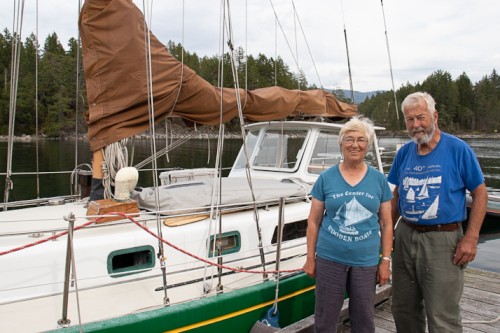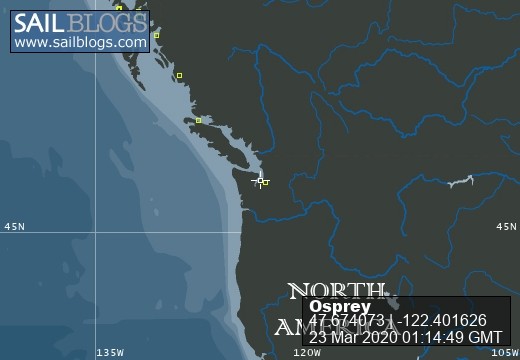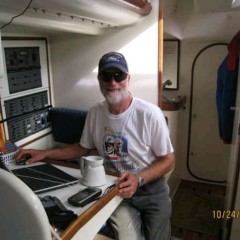Voyages North
23 July 2023
21 August 2021
11 July 2021 | Posted in Seattle
16 May 2021
07 January 2021
10 April 2020 | Posted in Seattle
31 August 2019 | Posted at Port McNeill
31 August 2019
30 August 2019
30 August 2019 | Posted at Port MCNeill
13 August 2019 | Posted at Prince Rupert
13 August 2019 | Posted at Prince Rupert
03 August 2019 | Posted at Ketchikan
02 August 2019 | Posted at Metlakatla
02 August 2019 | posted in Metlakatla AK
22 July 2019 | Posted at Klawock/Craig
22 July 2019 | Posted at Klawock/Craig
09 July 2019 | Posted at Juneau
09 July 2019 | Posted at Juneau
27 June 2019
July 26, 2018. Klemtu. A Modern Pictograph
21 August 2018
Elsie Hulsizer

Photo: A pictograph on Cone Island
We were approaching Klemtu, a Kitasoo / Xai’xais village on British Columbia’s north coast when I saw the pictograph on Cone Island: a canoe with a series of hands beneath it, all done in dark-colored ochre. This was no usual pictograph, faded with age, its colors smeared. We hadn’t seen any reports of pictographs here but the cliffs to our starboard were ideal for them so we had been idly scanning them as we motored along.
“Hey!” said Steve and pulled back the throttle. He motored Osprey closer to the pictograph so we could see it in more detail. Where most pictographs were almost primitive, like stick figures, this was more robust. I could almost imagine it on the wall of a gallery.
I was thrilled to see it and delighted to learn later that it had been done by school children at Klemtu who had researched and experimented with different binders for the ochre, finally concluding that the traditional mix of ochre and fish eggs was the best. They had painted it in 2016 and it still looked brand new. And in making the design modern, they had taken their traditional art into the present. I hope this is the beginning of a trend.
As we approached the village, I heard the croak of a raven, then the clonk of another: the sounds of a first Nations village.
We turned the corner to see the town mostly unchanged since the last time we had visited although somewhat grown with the addition of more houses. The Big House on the point still dominated the village. Houses circled the bay with a large fish processing plant on the north end. We anchored in the center of the bay, thankful there were no other boats. Although the bay appeared to be of good size, extensive shallows along the shore and a deep area in the center limited swinging room. There was just room for our boat plus one or two others at the most.
We had come here because it was on our way to Meyers Passage where we were going to look for pictographs, but also because I had forgotten to buy eggs at our last stop, Shearwater.
The Band Store was already closed for the day but was due to open at 9:30 the next morning. So that morning, while Steve puttered around the boat, I rowed to a small dock and walked the few steps to the store. A clerk was just opening the door and starting up the cash register when I arrived.
“Where are the eggs?” I asked.
“No eggs,” she answered.
My expression must have shown my dismay because she quickly added, “We’re suffering too. But we’ll get another shipment tomorrow when the ferry comes in. We hope there will be eggs but sometimes they just send dry goods.“
I rowed back to Osprey pondering the tribulations of living in a small isolated community dependent on a ferry.
We left for the day but returned that afternoon. On our way back we’d passed the ferry dock unloading people and goods from the biweekly ferry arrival. No point in checking for eggs yet.
The sun was shining; it was a good day for a walk.
At the dock, a young woman took our dinghy line and chatted with us. Her name was Chantelle she told us and she worked as a Coastal Guardian. “I protect our resources,” “Things are much better now than the old days.” Then she laughed, “I mean than before I was born. “I’m only 24.”
We started our walk around the bay, on a sidewalk that ran along the water. Periodically a bench interrupted the sidewalk and next to each bench a bear-proof trashcan painted with a picture of a bear. They were evidently a success as we saw little litter. I recalled a conversation I had once had here with another boater. “It wouldn’t be a bad place if they just cleaned up the litter,” he told me. I looked at him in amazement. That would never happen, I thought, thinking of other Native villages I had visited. I was glad to know I’d been wrong.
At the end of the sidewalk, we turned at a newly painted totem pole and followed a road up a hill. Near the top was a modern new building. A youngish man stood on the porch.
“Are you staying at the lodge?” he asked, referring to the Spirit Lodge next to the water. When we told him we were on a sailboat and had been looking for pictographs, he invited us into his office to look at a large map. His name was Doug and the building was the new home of the Stewardship Office. All the Northern BC First Nations were working together to preserve their resources. He was optimistic. Someday they hoped to see the salmon runs come back. We told him we’d met Chantelle. “She’s my girlfriend,” he replied. This was a small town.
I left feeling optimistic about the future of Klemtu and the Northern BC resources.
The next morning we took the dinghy back to the dock and walked up to the Band Store. In the refrigerated display case at the back, we found stacks of full egg cartons just unloaded from the ferry.
We were approaching Klemtu, a Kitasoo / Xai’xais village on British Columbia’s north coast when I saw the pictograph on Cone Island: a canoe with a series of hands beneath it, all done in dark-colored ochre. This was no usual pictograph, faded with age, its colors smeared. We hadn’t seen any reports of pictographs here but the cliffs to our starboard were ideal for them so we had been idly scanning them as we motored along.
“Hey!” said Steve and pulled back the throttle. He motored Osprey closer to the pictograph so we could see it in more detail. Where most pictographs were almost primitive, like stick figures, this was more robust. I could almost imagine it on the wall of a gallery.
I was thrilled to see it and delighted to learn later that it had been done by school children at Klemtu who had researched and experimented with different binders for the ochre, finally concluding that the traditional mix of ochre and fish eggs was the best. They had painted it in 2016 and it still looked brand new. And in making the design modern, they had taken their traditional art into the present. I hope this is the beginning of a trend.
As we approached the village, I heard the croak of a raven, then the clonk of another: the sounds of a first Nations village.
We turned the corner to see the town mostly unchanged since the last time we had visited although somewhat grown with the addition of more houses. The Big House on the point still dominated the village. Houses circled the bay with a large fish processing plant on the north end. We anchored in the center of the bay, thankful there were no other boats. Although the bay appeared to be of good size, extensive shallows along the shore and a deep area in the center limited swinging room. There was just room for our boat plus one or two others at the most.
We had come here because it was on our way to Meyers Passage where we were going to look for pictographs, but also because I had forgotten to buy eggs at our last stop, Shearwater.
The Band Store was already closed for the day but was due to open at 9:30 the next morning. So that morning, while Steve puttered around the boat, I rowed to a small dock and walked the few steps to the store. A clerk was just opening the door and starting up the cash register when I arrived.
“Where are the eggs?” I asked.
“No eggs,” she answered.
My expression must have shown my dismay because she quickly added, “We’re suffering too. But we’ll get another shipment tomorrow when the ferry comes in. We hope there will be eggs but sometimes they just send dry goods.“
I rowed back to Osprey pondering the tribulations of living in a small isolated community dependent on a ferry.
We left for the day but returned that afternoon. On our way back we’d passed the ferry dock unloading people and goods from the biweekly ferry arrival. No point in checking for eggs yet.
The sun was shining; it was a good day for a walk.
At the dock, a young woman took our dinghy line and chatted with us. Her name was Chantelle she told us and she worked as a Coastal Guardian. “I protect our resources,” “Things are much better now than the old days.” Then she laughed, “I mean than before I was born. “I’m only 24.”
We started our walk around the bay, on a sidewalk that ran along the water. Periodically a bench interrupted the sidewalk and next to each bench a bear-proof trashcan painted with a picture of a bear. They were evidently a success as we saw little litter. I recalled a conversation I had once had here with another boater. “It wouldn’t be a bad place if they just cleaned up the litter,” he told me. I looked at him in amazement. That would never happen, I thought, thinking of other Native villages I had visited. I was glad to know I’d been wrong.
At the end of the sidewalk, we turned at a newly painted totem pole and followed a road up a hill. Near the top was a modern new building. A youngish man stood on the porch.
“Are you staying at the lodge?” he asked, referring to the Spirit Lodge next to the water. When we told him we were on a sailboat and had been looking for pictographs, he invited us into his office to look at a large map. His name was Doug and the building was the new home of the Stewardship Office. All the Northern BC First Nations were working together to preserve their resources. He was optimistic. Someday they hoped to see the salmon runs come back. We told him we’d met Chantelle. “She’s my girlfriend,” he replied. This was a small town.
I left feeling optimistic about the future of Klemtu and the Northern BC resources.
The next morning we took the dinghy back to the dock and walked up to the Band Store. In the refrigerated display case at the back, we found stacks of full egg cartons just unloaded from the ferry.
Comments
| Vessel Name: | Osprey |
| Vessel Make/Model: | Annapolis 44 sloop |
| Hailing Port: | Seattle |
| Crew: | Steve and Elsie Hulsizer (author of Glaciers, Bears and Totems and Voyages to Windward) |
| About: | |
| Extra: |
Osprey's Photos - Main
No items in this gallery.
Voyages North on SV Osprey

Who: Steve and Elsie Hulsizer (author of Glaciers, Bears and Totems and Voyages to Windward)
Port: Seattle


